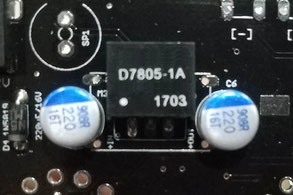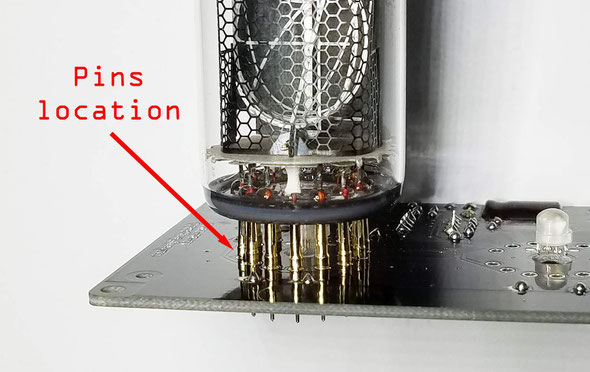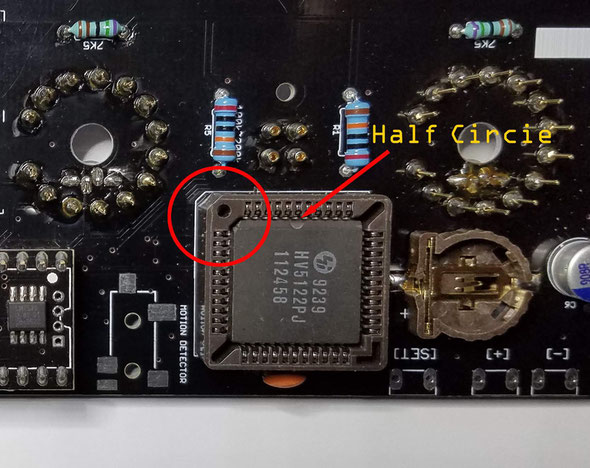This is a 100% fully open hardware circuit(with the MCU main board circuit), IN-18 6-tube NIXIE clock DIY kit by using DIP components.
Because of hard to find the MCU that we are using in DIP package,we created a PCB,it converts the SMD MCU to DIP-SOW module,thus you do not need to solder SMD MCU, the module has been fully assembled and tested.
It costs us over two years time and 7 versions of PCB design.
All plug-gable design,all the IN-18 tubes and middle comma dots are all plug-gable,you can replace the NIXIE tubes and middle commas by hand.
And the Main MCU board and NIXIE driver Chips are all plug-gable on the PCB.
In Current Version we have moved all the equipment to the bottom of the PCB. It only has Female socket PINs and LEDs on the TOP of the PCB.
All the info shown blow is for reference only,we may change the circuit and PCB etc. without notification!!!
DIP-IN-18 6-tube Clock DIY version
Assembly Instructions
V1.0
Notice
For assembling the NIXIE KIT you need to have the skill of soldering DIP components. We use a Hakko FX-888 Soldering Station (with CF2 Iron Head). We use 183℃(degree C)low melt temperature solder
wire S60, 0.5mm(Dia.), Brand Almit.
For how to solder the DIP components, we recommend:
https://www.hakko.com/english/tip_selection/type_bc_c.html
https://www.hakkousa.com/video/
Please do not change any equipments of the KIT or you may not be able to get the KIT in working.
Because it left almost no SMD components(The only one is big MOSFET may in SMD package), so it is very easy for you to assemble, we recommend to check the circuit diagram carefully and follow the
steps shown blow.
We do not recommend you to solder the components in random order or if it has problems you will need more time for de-soldering(*Will damage the PCB Pad) and debug, we recommend you follow the steps in this instructions that you can do part test after finished each step.
For more info & update, please visit HTTP://vfdclock.jimdo.com
Or contact us: zjjszhangf@gmail.com
Thanks for choosing our product.
Building it
Well, because of the circuit is block based and not very complicated, all you need to do is get all the components in the right position and make sure no short or no float before you plug the
power in. We will show the soldering steps blow.
Preparing
1. Please print out the PCB installation diagram by yourself, the Circuit diagram is no need for soldering job, print it or not depends on you(Note: May only have the paper circuit diagram in the
KIT with no digital version provide.);
2. Check all the components in the kit bag, make sure nothing is missing (You can do this on a A4 white copy paper);
3. We recommend using a soldering station and small soldering tip for soldering this kit (we use F2 or CF2 type tip). We recommend using ~180℃ type soldering tin for this job. Please do not use
the high temperature soldering tin in this project or you will damage components or the PCB;
Please always remember that in this new version,only LEDs and NIXIE PINS and comma PINs are installing on the TOP side of PCB,others are all on the bottom side of PCB.
And double check the component before you solder it on PCB, and also double check its' direction for some diode and caps etc.,DO not go wrong,because of if go wrong,de-soldering DIP component is not very easy, may damage the PCB pad.
Step (1): 12VPower In and 5V Power Out
Solder the [Power In&12V->5V] part first; This part contains a 5.5/2.1 12V power in socket and 12V->5V circuit.
This part is easy,it contains a 5.5/2.1 12V in socket,a fuse,a diode,and a typical 7805 12V-5V convert circuit which contains a 7805 chip and two caps.
For the diode, please check the direction carefully, the cathode side contains a white mark.
Also take care of the C5 and C6(Aluminum Electrolytic Capacitor), it has polarity, do not install it in invert direction;
After soldering this part,you can plug the 12V in,then measure to see if the C6 has 5V output;


Tips:
The 7805 works fine in this design, if wanna get higher efficiency of the 12V->5V part,you can use some 12V->5V 3pin DC-DC module to replace 7805 Chip(Like the D7805 in the pic).

In some of versions,we also designed an optional DC-DC module install pins on the PCB for easy to replace the regular 7805 circuit;
If have this DC-DC version of KIT,just need to solder the 12V->5V DC-DC module on the PCB, and no need to solder the two in&out capacitors, because of caps are already on the module;
Step (2): Middle comma Pins and MCU IC socket pins
We need to solder some pins in this step,please solder it in this step,will be easier to be installed.
The first PINS are middle comma female pins,please plug the Female PINs on the top of the PCB then cover a had board like a small PCB or
small wood board etc.over the PINs, use two clamps to hold it with the main PCB, then flip the PCB. Now you can solder on the other side.
Tips: Because of the PINs are through hole version, please solder it carefully and do not let the tin goes in to the inside of the pins or will damage the PINs. If necessary, you can plug a
wood/bamboo toothpick in the bottom of PINs hole when soldering.
Then solder the MCU IC sockt on the bottom of the PCB,this part is easy,just plug the IC socket in the PCB,flip it and press it on the table,then solder it. Please take care of the direction of the IC socket(check the first leg mark of the socket), do not go invert and do not go wrong PCB side.

Step (3): Install LEDs
The LED part contains 6pcs LEDs(With Chip inside it) and 6pcs 0uF(100nF) caps; Please note that the LED should be installed on the top side of the PCB, and take care of the first leg of the LED(The first leg is on the FLAT side of LED, and the LED pad has a white [.] and flat line to point out the first leg on PCB); Please solder the LED fast to prevent its be damaged;
The LED legs are very close,please solder carefully. Do not short any legs.
After soldering one LED,we recommend you plug the power on to give it a test,make sure it works before install the next LED.(Remember to plug the MCU module when you test LED(s));
Do not forget to solder the 0u1(100nF) capacitor(s) near LEDs in this part on the bottom of PCB,and cut the legs as short as it can be installed;

Notice:
In some of the PCB may contain a serial of SMD version of LEDs' pad in front of the PCB,these are for SMD version of LEDs and also has 0603 100nf caps on the back side of PCB, no need to install in DIP version,just ignore it.
We have sent the first 10PCS test KIT for the NIXIE DIY fans in the world, the returning info shows that they felt soldering the LEDs is the hardest part in this KIT, because of LED is heat sensitive component and the PINs are very close, easy to get short when do soldering. To solve this problem, we have improved the LED PAD design and add soldering tips blow for you to check.
Tips for soldering LED:
First plug the LED in the install place on the TOP of PCB(double check the direction, do not go invert),and use a PCB/Wood-Board etc.(like 1.6mm thick one) on one edge side of LED, it lifts the LED up a little bit,then you can plug a cotton applicator with alcohol on the other side,then flip the PCB,and solder all the LED legs.
Please do not cut the LED legs before soldering,if cut it short first, legs will be easy to short in soldering.

Soldering led legs tips:
We have improved the LED PAD into offset pad design, one side is longer than the other side for easy soldering. We recommend put the iron head on the longer pad to heat it up first then put the tin wire on the other side.
Soldering the left and right legs are easy, please solder these two legs first to fasten the LED, the hardest part is soldering the middle two PINs, may get short in this kind of small distance. We recommend use aluminium foil to cover the other legs first, then solder the middle legs one by one in between.(Check the Pics shown blow)
After soldering all legs, you need to double check to see if have any problems, if all fine, you can cut the legs in short.
If have any short, please use desoldering wick to solve the problem.
Always remember to solder the LED legs fast or will damage the LED!!!


Step (4): HV part
The HV part is the major part of the design,it converts 12V to 165~170V high voltage,please take care of this part, do not get electric shock.
Please take care of the directions of diodes and Aluminum Electrolytic Capacitors in this part, do not go invert. And the mosfet Q4 is in SMD package, do not forget to solder the big pad on the top of the mosfet!!!
Do not forget the small glass diode D3 on the left side;
This part of the circuit contains two Jumpers,[VIN] for 12Vin, and [HVOUT] for HV output, remember to solder these two jumpers close. We design these two jumpers for easy to separate the HV part
circuit from other circuits, easy for debuging;
After soldering all component(* Do not go power on if only solder part of the components of this circuit or the HV output will lost control and damage
things!!!) in this part of circuit, and double check, then you can plug the 12V in. If the circuit in working, you will get about 165V~170V output between the two legs of the C3 HV output
capacitor;
The HV output cap. and Inductor need to be installed in 90 degree as shown in the pic blow;
Tips:
For the safety, recommend do not use any socket in the HV part of the circuit,and solder everything carefully in this part.
If the HV part did not work,please double check and fix the problem,do not do the next step if this step in no working!!!
Do not touch any part of the HV part when power on!!!

Notice:
For the two C8 and C9 input Aluminum Electrolytic Capacitors in this part, may only have one big Aluminum Electrolytic Capacitor in the kit,in this situation you can solder the big one in 90 degree way as pic shown blow.

Step (5): PLCC sockets and misc Resistors and Caps etc.
This part is has two PLCC sockets,just plug the socket in the right direction(Please check the pic blow) then solder on the other side of the PCB.
Remember to solder two 0u1(100nF) caps in this part;
Also remember to solder 6pcs 7k5 IN-18 resistors and 4pcs resistors for middle commas;
And one CR1220 battery socket on the right side of the PCB ,near 7805 part,take care of direction.
And CDS and IR receiver(Optional) on the front side of the PCB;


After finishing this part,about 80% of the PCB soldering job has done.
Step (6): IN-18 PINS
Now we are going to solder the IN-18 PINS.Please flip the PCB to the front side,the PINS need to be installed on this side and please solder it on the middle part of the PINs;
First we recommend you plug the PINS in the IN-18 legs,then plug ALL the PINS to the install holds,plug it down to the middle part, then flip the PCB ,solder the PINs on the bottom side of PCB;
!!!Plase double check to see if all PINs are plugged to the middle part before you solder the PINs!!!



In soldering the PINS,if necessary,you need to keep pushing the tubes down to make sure all the PINS have been soldered on the middle part, please trade care of this part.
!!!Pleas note, do not add too much tin in soldering PINs,and please solder it fast. If add to much tin, the tin may go inside of the PINs and will solder the IN-18 tube legs with the socket,which will be big problem. We recommend add a little bit body lotion or oil on the surface of all in-18 PINs, will help to prevent be soldered together with socket.
And after finished soldering on tube PINS,give it a power on test(*Remember to plug the MCU module and HV driver Chips in socket for testing) to see if have any problem. If all ok, move to the next tube location;

After soldering and testing,if all fine,you can cut the thin part of PINS under the PCB if you want to or just leave it uncut depends on you.
We recommend cut it off,because the end of legs is soft, may cause short.

Step (7): Power ON Test
After finished all the steps shown up, please recheck it to see if has errors on the PCB.
Then plug the two PLCC HV driver Chips and Main MCU module in the sockets; please double check the direction of IC and module before power
on, do not go wrong direction.
Now we can plug the 12V power in, if all fine, the NIXIE tubes will display the time.We recommend plug one NIXIE tube in when in the first time power on test, if first NIXIE tube works, you can
go power off and add another one, do test again...etc., until all 6 tubes are all in working;
If find errors or the the clock did not work, please go power off and re-check the circuit block by block to see if it has any short or float on PCB;


Step (8): Cleaning the Circuit Board
You can use the household rubbing alcohol and a toothbrush to remove the solder flux on the PCB.
If available, the anhydrous alcohol (used for electronics cleaning) works much faster. Blot the cleaned area with a non-linting tissue (like Kimwipes EX-L) or a clean towel or you can do it in your own way.

!!!Remember to remove the HV driver Chips and the MCU main board when cleaning the PCB!!!
You need to have a PLCC EXTRACTOR for unpluging the PLCC chip from the socket;
Step (9): Buttons and Buzzer etc.
Because of Buttons and Buzzer etc. can not be washed, we need to solder 4pcs Keys and 1pcs Buzzer after cleaning the PCB.
If the Buttons are one side two pins version,just solder it directly on PCB,if the Buttons are two side 4pins version,cut one side 2 pins off buy yoursele,and band it flat the other side of 2pins then solder it and cut it short(or cut it short first before soldering);

It also has two 3.5mm plug socket,one is for GPS, the other is for "PIR Motion Sensor";Please remember to solder these on PCB too;
And do not forget to solder the 3-brand switch (If has, some version may move this switch to the PIR sensor side) for the "PIR Motion Sensor",and remember to switch it to "ON/Auto" not "OFF" part to prevent it turns the HV output OFF when in the testing;


Extras (10): Create middle comma
For how to assembling the Middle comma,please visit:
KIT-Create the Middle Dot Comma for IN-18 NIXIE clock
You can make your own decision of the location of the bulbs in the middle glass tube.
Extras (10): misc extras
In editing...
test
In editing
 NIXIE CLOCK DIY
NIXIE CLOCK DIY









